Creating symmetrical garden layouts is a beautiful way to achieve balance and harmony in your outdoor space. I love the classic rectangular garden layout with its straight lines, or the circular design that invites a central focal point like a stunning birdbath. The mirror image flower beds evoke tranquility, while tiered gardens bring a unique visual interest to sloped terrains. Stay with me, and you'll discover even more tips on achieving perfect balance in your garden design.
Quick Takeaways
- Classic rectangular layouts utilize straight lines and symmetrical borders for efficient space and visual harmony.
- Circular designs with a central focal point, like a birdbath or sundial, promote balance and engagement.
- Mirror image flower beds create tranquility through identical plant arrangements on either side of a central axis.
- Quadrant planting in square gardens maximizes land use and enhances symmetry while maintaining plant health.
- Symmetrical pathways guide visitors through the garden, enhancing the overall visual flow and harmony.
Classic Rectangular Garden Layout

When I think of a classic rectangular garden layout, I often envision a space that embodies both elegance and order.
With its straight lines and right angles, this design maximizes space efficiency, making it perfect for various gardens. The rectangular borders create a symmetry that enhances visual harmony, allowing for balanced features on either side. I love how pathways of gravel or stepping stones guide visitors, while identical planters reinforce that sense of stability. Additionally, incorporating diagonal garden paths can further enhance the visual perception of space, drawing the eye across the garden.
This minimalist approach not only showcases the beauty of plants but also inspired me to create Botanical Mood, sharing innovative ideas for enhancing our green spaces. Achieving classic proportions in garden design can elevate the overall aesthetic, ensuring a timeless appeal.
Circular Symmetry With Central Focal Point
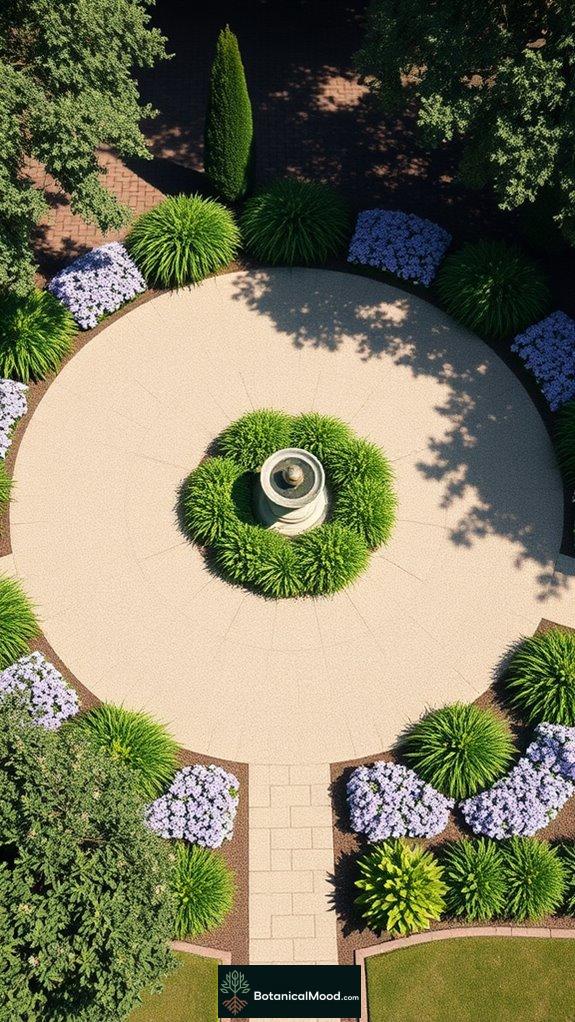
A classic rectangular garden layout provides a structured foundation, but embracing circular symmetry with a central focal point can elevate your garden design to new heights.
- Consider a stunning birdbath that invites nature.
- Opt for a graceful sundial that combines function with aesthetic.
- Choose a large sculpture to draw the eye and inspire conversation.
With careful focal point selection and strategic lighting effects, your circular design will shine both day and night, creating an inviting atmosphere. Incorporating symmetrical elements in your design will further enhance the sense of harmony and balance throughout the garden.
I created Botanical Mood to help fellow garden enthusiasts explore innovative designs like this, enhancing our appreciation for nature's beauty in our own spaces.
Radial Design With Pathways Leading to a Center
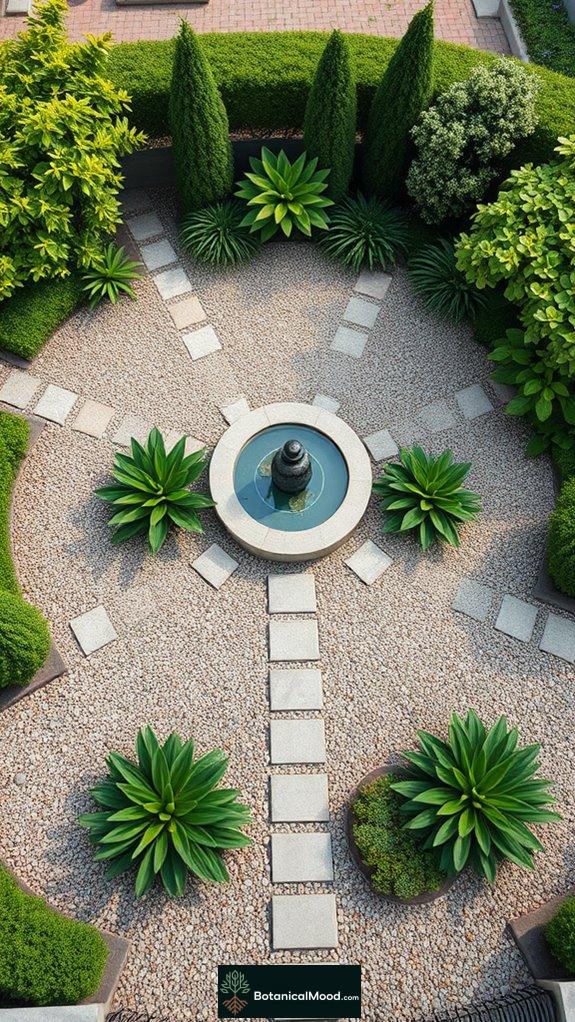
Embracing the beauty of radial design, I find that pathways leading to a central focal point create an engaging and dynamic garden experience.
With carefully chosen pathway materials like natural stone or gravel, I enhance the garden's rustic charm while ensuring low garden maintenance.
Incorporating a central water feature amplifies visual balance, inviting garden exploration from all angles.
Layered planting adds depth, with taller plants near the center, creating a stunning backdrop for leisurely strolls.
This design offers remarkable flexibility, allowing pathways to intersect creatively, ensuring that my garden remains an innovative sanctuary for all who visit. Additionally, geometric pathway designs can further enhance the overall aesthetic and functionality of the garden layout.
Mirror Image Flower Beds
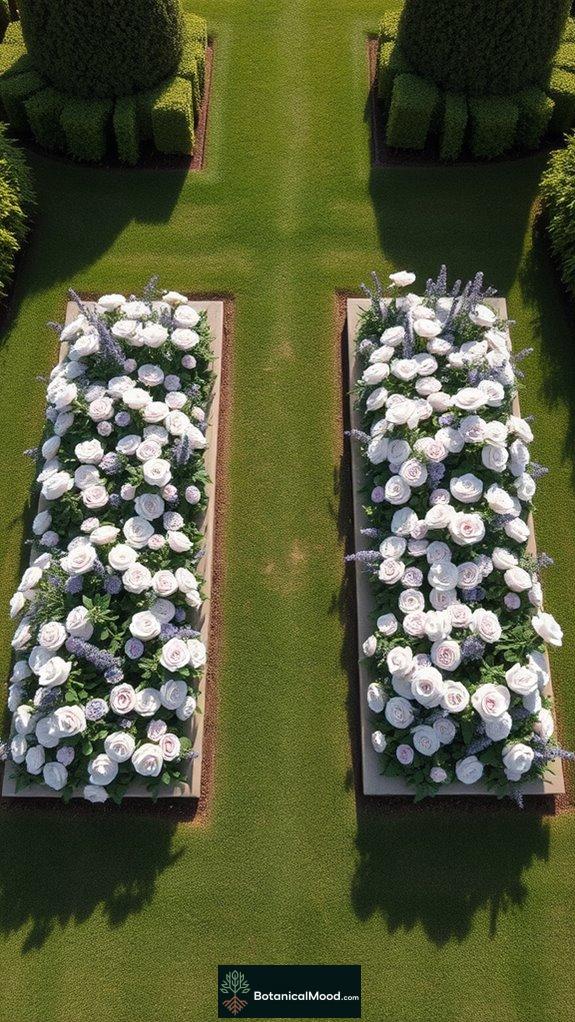
Creating mirror image flower beds transforms any garden into a stunning display of symmetry and elegance, allowing me to appreciate the beauty of nature in a structured way.
Transform your garden with mirror image flower beds for a stunning, serene display of nature's beauty.
To achieve floral balance, I focus on:
- Centerline Alignment: Establish a clear axis for symmetry.
- Identical Plant Choices: Select plants that mirror each other in size and color.
- Consistent Visual Weight: Guarantee equal density on both sides for a polished look.
This design not only creates harmony but also evokes tranquility. In classic French gardens, symmetrical formal garden design is often emphasized, enhancing the overall aesthetic appeal.
I love sharing these innovative ideas through Botanical Mood, inspiring others to embrace the art of symmetry in their gardens.
Geometric Box Garden Design
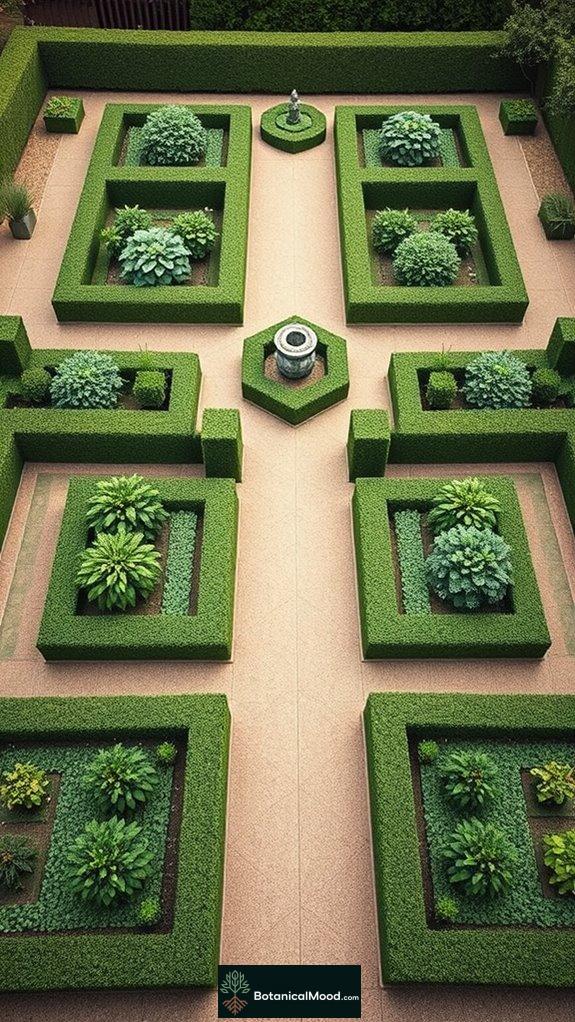
Geometric box garden designs offer a mesmerizing approach to landscaping, where structure and form take center stage.
I find that these designs, with their square and rectangular shapes, create a sense of order and elegance. To achieve stunning results, I focus on geometric plant selection, emphasizing clipped box hedges for that perfect symmetry.
Regular box hedge maintenance keeps those sharp lines crisp and enhances the overall visual impact. The interplay of geometry not only defines spaces but also draws the eye to focal points, making these gardens both inviting and enchanting. Additionally, incorporating abstract landscape techniques helps elevate the design by adding layers of depth and interest.
Through Botanical Mood, I aim to inspire others to embrace this innovative style.
Symmetrical Hedge Maze
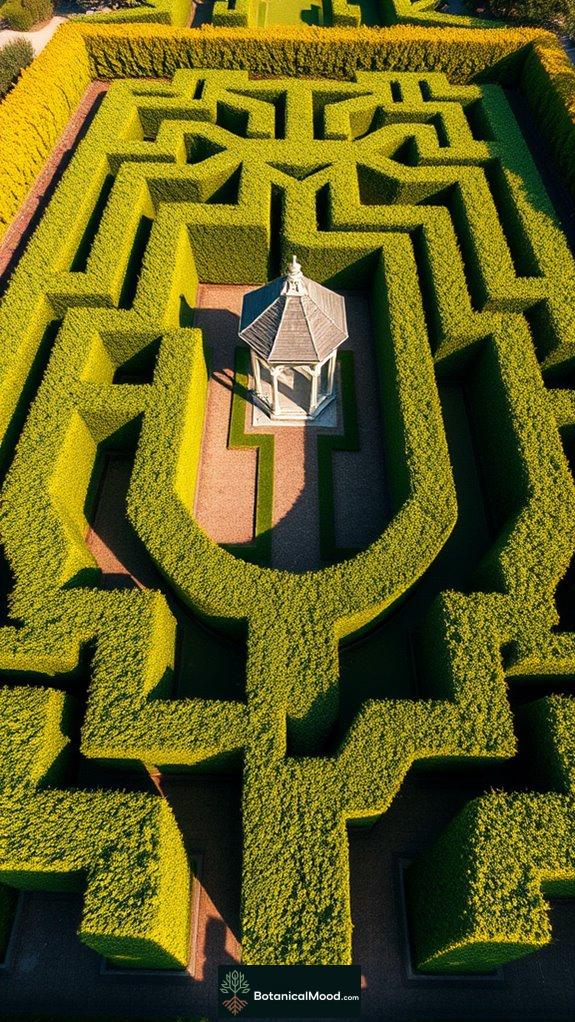
Symmetrical hedge mazes captivate the imagination with their complex designs and orderly aesthetic.
When I navigate these enchanting spaces, I'm drawn to:
- Tall, neatly trimmed hedges that create a stunning visual barrier.
- Elaborate pathways that guide me through a maze of wonder.
- Central features, like gazebos, that serve as delightful focal points.
Regular hedge maintenance is essential to preserve their beauty, ensuring that every turn offers clarity in maze navigation.
Regular upkeep of hedges is vital for maintaining their charm, providing clear pathways in the enchanting maze experience.
As I explore, I appreciate how these mazes enhance gardens, creating fun, private spaces. Additionally, these mazes often reflect medieval landscape architecture principles, showcasing the historical influence on modern designs.
It's this passion for design that inspired me to create Botanical Mood, sharing my love for innovative garden layouts.
Dual Pathways With Symmetric Planting
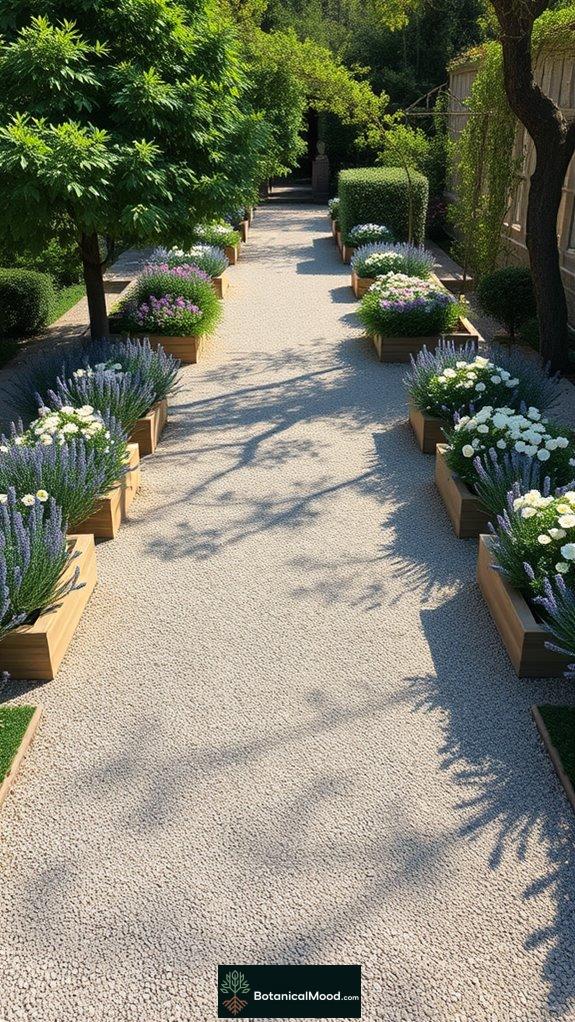
In a well-designed garden, dual pathways not only guide the eye but also create an inviting atmosphere that beckons visitors to explore.
By utilizing pathway materials like gravel or brick, I find that these routes can enhance the garden's symmetry. On either side, I employ innovative planting techniques, arranging identical species or colors to maintain balance and harmony.
I often incorporate raised planters to add depth, while seasonal flowers bring vibrant life to the design. Additionally, implementing height layering techniques ensures that each plant contributes to a lush and dynamic landscape.
This meticulous approach guarantees that my garden remains visually striking, highlighting the beauty of symmetry.
It's this passion for design that inspired me to create Botanical Mood.
Formal Parterre Garden Layout

Creating a formal parterre garden layout can transform your outdoor space into a masterpiece of design, especially when you appreciate the elegance of symmetry and order.
Consider these three elements for your parterre plantings:
- Geometric shapes: Arrange flowers and shrubs in crisp squares or circles.
- Evergreen hedging: Use *Ilex crenata* or *Taxus baccata* to frame your design.
- Year-round interest: Incorporate hellebores and tulips for continuous blooms.
With careful garden maintenance, you can achieve a stunning visual appeal that complements your home's architecture, just as I envisioned when creating Botanical Mood. Additionally, consider using companion planting strategies to maximize your garden's yield and enhance plant health.
Square Garden With Quadrant Planting

When I envision a square garden with quadrant planting, I see a beautifully structured space that invites both practicality and aesthetic pleasure. This layout offers quadrant advantages, creating symmetry while maximizing land use.
I love incorporating diverse planting strategies, like pairing herbs such as basil and rosemary with vibrant vegetables like tomatoes and cucumbers. The intersecting paths not only enhance accessibility but also add visual appeal.
Each quadrant can be rotated seasonally, ensuring soil health and preventing pests. This method reflects the historical influence of cultural heritage landscape patterns, inspiring my passion for gardening at Botanical Mood, where beauty meets functionality.
Tiered Garden With Balanced Levels
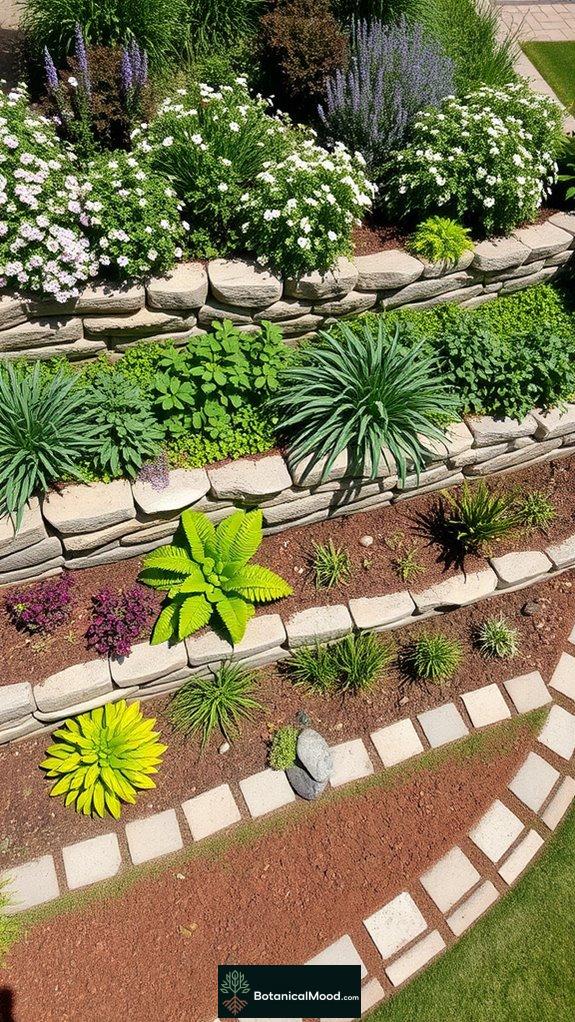
While exploring the concept of tiered gardens with balanced levels, I find myself captivated by how they transform sloped terrains into visually stunning, functional spaces.
Imagine these elements:
- Tiered planters that create dynamic planting zones, each with unique flora.
- Retaining walls formed from bricks or natural stones, adding texture and stability.
- Thoughtful pathways that guide visitors through lush greenery, enhancing movement and interaction.
With balanced elevation, these gardens not only showcase beauty but also serve practical purposes. Incorporating innovative designs allows us to create spaces that inspire, reflecting the very essence of what I envisioned for Botanical Mood.
Centerpiece Focal Point Arrangement

A well-arranged centerpiece can transform a garden into an enchanting sanctuary, drawing the eye and inviting exploration.
Choosing the right centerpiece materials is crucial; I often opt for weather-resistant options like stone or durable metals. In symmetrical designs, large urns or sculptures create a striking focal point, while asymmetrical layouts can feature living tree sculptures for dynamic seasonal interest.
To enhance visual harmony, balancing elements around the centerpiece is key. Incorporating seasonal bloomers and evergreens guarantees year-round appeal, keeping the garden vibrant.
As I designed Botanical Mood, I aimed to inspire you to create your own unique oasis with these principles in mind.
Geometric Pattern Arrangement Techniques

Geometric pattern arrangement techniques play an essential role in designing gardens that not only captivate but also create a sense of order and beauty.
Here's how I approach these innovative designs:
- Grid layouts offer structured elegance with parallel lines.
- Circular designs draw the eye to focal points like ponds or sculptures.
- Triangular arrangements guide movement through dynamic plantings.
Symmetrical Pathway Configuration

Creating a symmetrical pathway configuration can transform your garden into a harmonious retreat, where every path invites exploration and admiration.
Aligning paths to mirror each other on either side of a central axis creates visual flow, guiding the eye toward a stunning focal point.
Using consistent pathway materials, like bluestone pavers, enhances this symmetry while integrating features like identical garden beds or water elements.
Don't forget about symmetrical lighting; placing fixtures evenly along the pathways not only illuminates but also accentuates the design.
I created Botanical Mood to share how these elements can elevate your garden into a beautifully balanced space.
Designing for Visual Harmony
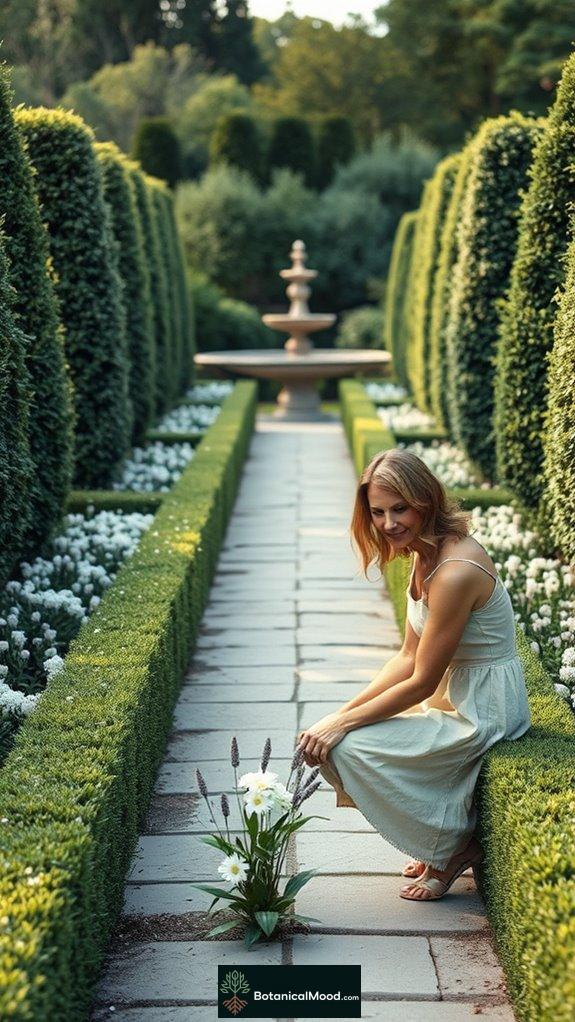
While designing a garden, attaining visual harmony is essential to create a space that feels inviting and balanced.
To attain this, I focus on:
- Color Harmony: Selecting plants that complement each other enhances the garden's aesthetic appeal.
- Texture Balance: Combining varying textures adds depth and interest, making the space feel alive.
- Spatial Arrangement: Thoughtful layout optimization guarantees that every element contributes to the overall design principles.
References
- https://www.marshalls.co.uk/gardens-and-driveways/blog/rectangle-garden-ideas
- https://www.aldalandscapes.co.uk/2021/12/designing-with-balance/
- https://www.gardenary.com/blog/large-garden-design-inspiration
- https://pithandvigor.com/2024/06/garden-shapes/
- https://www.greenwashingindex.com/stunning-raised-bed-garden-layouts/
- https://squarefeetstory.com/how-to-plan-gardens-using-geometry/
- https://platthillnursery.com/symmetry-and-balance-in-the-garden-chicago/
- https://www.houzz.com/magazine/bring-more-balance-to-your-garden-with-symmetry-stsetivw-vs~74641494
- https://notanothergardeningblog.com/tag/balance-in-landscape-design/
- https://simpledecoratingtips.com/2019/05/13/before-after-circular-garden-2/
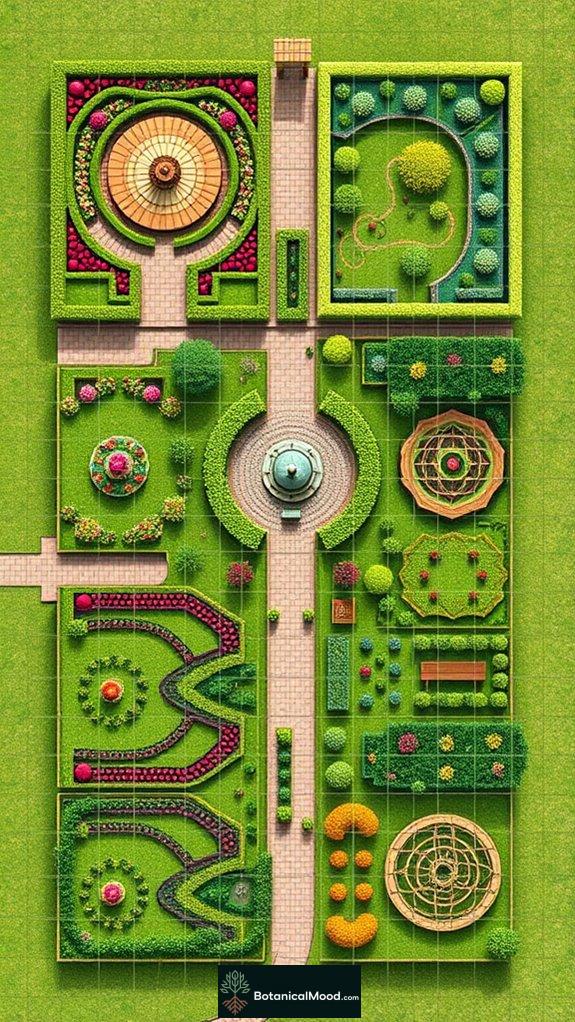
Leave a Reply